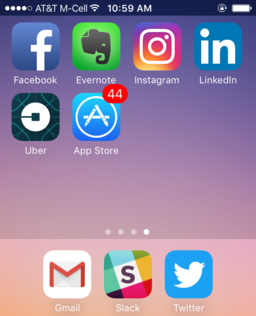
How to Effectively Manage Your Client-Partner Relationships
Clients Project StrategyClients leave when they feel that their needs aren’t being met. The strength of your client-partner relationship relies on a deep understanding of your client’s...

True fact: many of the native iOS and Android apps you use daily haven’t always been native. Recognize any of these apps on your homescreen?

If you thought most of these apps are native, you’d be right! But heretofore, substantial portions of these apps were powered by front-end web technologies. Since many of these apps ended up native, why were web technologies used in the first place?
Web-powered mobile apps have been the subject of much hype and flame wars. To confuse the matter, there is a lot of terminology around web-powered mobile apps. So let’s make sure we speak the same language!
Web apps are applications that (historically) run in a browser and are built with web technologies, namely JavaScript, HTML, CSS and the Web APIs. Web apps have a lot to offer:
There are also plenty of ways to ruin a web app with a poor user experience (UX). Users especially dread web apps that:
Native apps are iOS or Android apps that build on the operating system’s own unique platform rather than the web platform. On iOS, this means Swift + Xcode, and on Android it means Java + Android Studio. Users love native apps for a lot of reasons:
Native apps can also be frustrating for users:
A hybrid web app is an iOS or Android app where significant portions are implemented with web technologies. You’ll hear a handful of related buzzwords invoked when discussing hybrid web apps:
Not unlike end users, developers have their own reasons to prefer native or hybrid web apps to the other. With native apps, a developer can create a refined experience that tightly integrates with OS features and leverages hardware for maximum performance. But with a hybrid app, a developer can craft a good experience for multiple platforms with a single codebase and push out updates (“hot code push”) without awaiting app store approval.
So should you build separate native apps for Android and iOS, or a hybrid web app that can be deployed to both? This so-called “native vs. web” debate has sparked many flame wars of old, and it’s a misleading question because it focuses purely on the technical perspective while ignoring business needs and the release timeline. In fact, a hybrid web app can be the perfect catalyst to building a delightful native app!
At Big Nerd Ranch, we build a lot of MVPs (minimum viable products), especially for our startup clients. During the MVP process, there are inherently risks and unknowns we want to answer: Who is the target audience? What features will resonate with this audience? Is the core functionality technologically feasible?
According to the lean startup approach, the MVP is merely an experiment for testing a set of hypotheses, incrementally correcting them, or eventually pivoting towards a completely new approach! Since the MVP is only an engine for collecting data, it needs to be cheap and quick to develop.
Hybrid web apps can often help in executing the lean startup approach. Here are some questions you should answer to determine if the hybrid approach will fit your app:
If you answered “yes” to most (or all) of those questions, your app is a great candidate for the hybrid web app approach!
With any MVP, it’s important to plan a release timeline. If a hybrid web app is a good fit for your application, you have a new question to answer: when should you transition from the hybrid web app and build a native app to replace it? Here is a sample timeline:
Many well known services—like Instagram and Facebook—have taken similar approaches, but generally without much fanfare. It’s a clever strategy for preventing confirmation bias, a phenomenon that causes users to perceive and interact with an app differently when informed of its web nature.
Facebook wrote an exceptional postmortem in 2012 after they transitioned from their hybrid web app to a native iOS client. Their experience not only highlights the role that web can play in a service’s timeline, but also when it’s time to move on (emphasis added):
By allowing us to write once and ship across multiple platforms, HTML5 … has been instrumental in getting us to where we are today. We chose to use HTML5 because … it also allowed us to iterate on experiences quickly by launching and testing new features without having to release new versions of our apps.
So while utilizing web technology has allowed us to support more than 500 million people using Facebook on more than 7000 supported devices, we realized that when it comes to platforms like iOS, people expect a fast, reliable experience and our iOS app was falling short. Now that our mobile services had breadth, we wanted depth. So, we rewrote Facebook for iOS from the ground up…
There are many misconceptions about hybrid web apps that could adversely affect your decision when considering this approach. Here are some of the more common objections:
“My app needs to have a perfect native UX/UI at launch, or it will irrevocably flop.” Will an imperfect UX/UI kill your app? Unless you are a well-established service like LinkedIn, no, not at all. Services like Craigslist and Reddit aren’t especially beautiful or polished, but they deliver critical value, which translates to revenue. Furthermore, if an app’s exceptional UX/UI isn’t bringing in revenue, then its beauty translates to wasted money. Apps whose sole innovation is UX/UI are unlikely to survive long-term.
“Hybrid web apps don’t perform well.” Well-written hybrid web apps perform well even at 60 fps, so performance should not be a deciding factor until user data indicates otherwise. And if your web app is suffering from poor network performance, check out our case study on performance metrics.
“Hybrid web apps can’t interact with hardware.” With Cordova, web apps can access many hardware and OS integrations, in addition to those already supported in the browser (e.g. accelerometer, GPS, battery).
“Hybrid web apps don’t work offline.” Thanks to Web APIs like AppCache, ServiceWorkers and the storage APIs, web apps can offer a seamless offline experience.
Many popular services start out as hybrid web apps, not because they are superior replacements for native apps, but because they cater well to building an MVP. Instead of reliving the native vs. web debate, consider creating a successful service with a web app, then pivot on that success to build an exceptional native app.
If you feel that the hybrid approach will fit your needs, feel free to contact us. We focus on understanding your company’s goals and obejctives, and we will work with you to quickly determine if a hybrid web app is the best fit for you.

Clients leave when they feel that their needs aren’t being met. The strength of your client-partner relationship relies on a deep understanding of your client’s...

Responding to change is a key tenant of Agile Software Development. Predicting change is difficult, but software can be developed in a manner that...

A lot of this confusion surfaces around the scope of machine learning. While there is a lot of hype around deep learning, it is...